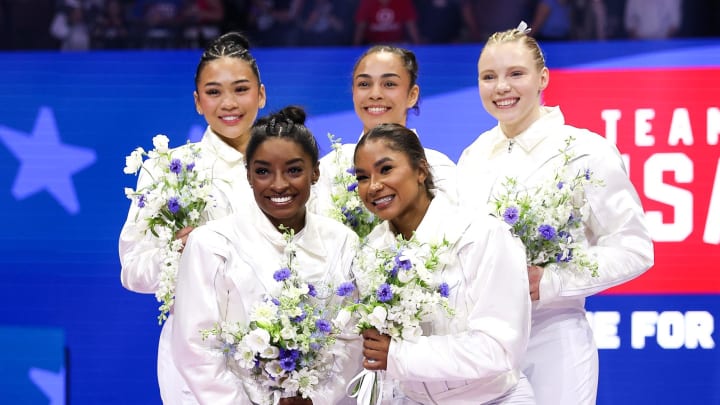Simone Biles Headlines a U.S. Gymnastics Team of Olympic Veterans and a Teenager

If you weren’t watching closely, you might have been confused: Red, white and blue streamers floated from the ceiling as Simone Biles, Suni Lee, Jordan Chiles and Jade Carey screamed and flung themselves into the air to celebrate their Olympic selection. Was this 2021? No, they were wearing white, not red; the trials were held in Minneapolis, not St. Louis; and instead of Grace McCallum and MyKayla Skinner, beside the quartet danced 16-year-old Hezly Rivera, who watched the Tokyo Games just after finishing seventh grade.
Yes, the U.S. named the Paris Olympic team on Sunday night, and for the first time since 1952, the Americans will send four female gymnasts to their second Games. And a sport once seen as the provenance of teenagers will be fronted by adults.
The U.S. squad, among the deepest in the world, limped to that moment, having in the preceding 96 hours lost three gymnasts with a combined 10 world medals among them. On Wednesday, Skye Blakely, 19, mistimed a tumbling pass while practicing her floor routine and ruptured her right Achilles tendon. On Friday, Shilese Jones, 21, landed wrong on a warm-up vault and injured her left knee. Some 15 minutes later, Kayla DiCello, 20, launched awkwardly on a vault and tore her Achilles. Jones in particular had seemed likely to compete alongside Biles in the all-around; all three had a good chance to make the team. But their absence gave an opportunity to Rivera—and to a cast of veterans who had to overcome a lot to be here.
In the end, said Alicia Sacramone Quinn, a member of the selection committee, “it was a pretty cut-and-dried, easy decision.”
Biles, 27, who automatically qualified for the Paris team after winning the all-around competition, becomes the oldest woman to compete for the U.S. in gymnastics in 72 years.
The competition was only Biles’s seventh since she contracted a case of the twisties—a sort of vertigo for gymnasts that causes them to lose their sense of where they are in the air—early in the Tokyo Olympics. She withdrew from event after event, eventually stripping the twisting elements from her balance beam routine and rallying to an emotional bronze medal.
She headlined her post-Olympic tour, performing only skills she knew she could land safely, then took nearly a year away from the gym. She tentatively returned in September 2022; by January ’23, she was practicing seriously. No one knew quite what to expect when she took the floor for her first post-twisties competition that August, but perhaps we all should have: She blew the field away. Ten months later, she still hasn’t lost an all-around competition in which she competed since ’13. In many ways, she’s a better gymnast than she was heading into Tokyo.
She attributed her performance to “being in a good mental spot,” she said, adding she is “seeing my therapist every Thursday.”
Lee, 21, could not even make it through her answer to that question. “A year ago, I didn’t even think this was—” she began, and then collapsed into tears. In that span, Lee has endured two chronic kidney conditions that left her coaches unsure about her future quality of life, let alone her gymnastics hopes. She began training in earnest only some seven months ago.
Chiles, 23, struggled so badly last year that she did not make the world championships squad, settling instead for a spot on the jayvee Pan-American Games team. And Carey, 24, made the risky decision to compete in her collegiate season at Oregon State last year while also training to make the Olympic team.
Rivera’s biggest challenge was being one of those once-ubiquitous teenagers. But after so many injuries hobbled the team, she found herself thrust into the spotlight. She shined, especially on the balance beam, an apparatus that could be a Team USA weakness: Biles, Chiles and Lee all fell off it on Sunday. In the first round of the team competition in Paris, each team will choose four gymnasts to compete on each apparatus and then drop the lowest score; in the final, it’s three athletes each, and all scores count. Biles, Lee and Chiles will likely compete on each apparatus. Carey’s strongest events are vault and floor routine. Rivera should shore up the team’s depth on uneven bars and balance beam.
Last time the U.S. barely held on for a silver medal, to Russia’s gold, in the team competition in the wake of Biles’s exit. Lee won the all-around competition and finished third in the uneven bars and fifth on the balance beam; Carey won gold in the floor exercise. This team is less deep than it might be if any of Blakely, Jones or DiCello had remained healthy. But Russia won’t be there this time. And the American women have done this before.
